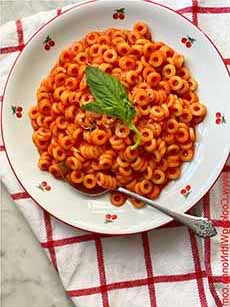Grown-Up, Homemade SpaghettiOs Recipe For National Pasta Month
|
We’ve been loading up on pasta recipes since October is National Pasta Month. It’s as good an excuse as any to try more recipes. We were charmed at the idea of Grown-Up SpaghettiOs in this recipe from DeLallo (yes, SpaghettiOs is the proper spelling—no hyphen, no apostrophe). SpaghettiOs was created to make dinner easier for parents, with cans of ring-shaped pasta pieces in tomato sauce. Just heat and eat! The brand markets it as “less messy” than regular spaghetti (and in fact, it is, scooping up the Os and sauce in a spoon, as opposed to twirling spaghetti and spattering or dripping the sauce). Television ads used the tagline, “the neat round spaghetti you can eat with a spoon.” And we still spontaneously break out into the jingle, “Uh-Oh! SpaghettiOs.” More than 150 million cans of SpaghettiOs are sold each year. Current options include the original plus versions with alphabet letters, franks, meatballs, calcium-fortified spaghetti, and popular characters: Disney Princess, Marvel’s Spider-Man, and Super Mario, Bros. Here’s the brand’s website. A bit of history: Tinned spaghetti—cut into short lengths, in tomato sauce—was available long before rings were introduced. In fact, it was first produced in New Zealand in the 1930s, along with tinned macaroni. It was probably the only type of pasta regularly eaten by New Zealanders until the 1950s, when a greater variety of pasta started to be consumed [source]. The ring-shaped SpaghettiOs were introduced in 1965 by the Campbell Soup Company, under its Franco-American brand. The Os were so popular with kids, that other companies rapidly produced their own spaghetti rings. Here’s a recipe that combines childhood nostalgia and a grown-up palate. The recipe uses ditalini, the smallest tubes pasta, often called thimble-sized. It is used in macaroni salad instead of elbows. Ditali were created in Apulia sometime during the industrial age (1760 to 1830), when developments in manufacturing engendered more short-cut pasta types. While DeLallo used ditalini instead of rings (photo #1), you can find ring-shaped pasta from Ronzoni (photo #3), or anelli (“rings” in Italian) imported from Italy (photo #4). Personally, for both nostalgia and food fun, we’d make the switch to rings (photo #2). And we’d buy imported anelli that’s cut with bronze die (photo #5). Why? Pasta makers can cut and shape their noodles old-style, with a traditional bronze die. It takes more time than a modern Teflon die. Bonze die-cut pasta creates noodles that have a slightly rough surface. This rough surface helps sauce and other ingredients stick to the noodles, so you get sauce and noodles in every bite. Pasta cut with a Teflon die, on the other hand, results in slick, nonstick noodles. The sauce and ingredients slide right off, into the bottom of the bowl or plate. Ingredients 1. COOK the pasta according to package instructions. Drain and set aside. 2. PURÉE the tomatoes in a food processor and set them aside. 3. HEAT the oil in a large sauté pan. Add the meatballs and cook until lightly browned on all sides, about 5 minutes. Transfer to a plate and set aside. 4. ADD the onion and garlic to the pan. Cook until the onion is translucent, about 5 minutes. Season with salt and pepper. 5. STIR in the tomato paste and cook for 1 minute. Add the paprika and pepper flakes and cook until fragrant. 6. ADD the sugar, basil, and reserved tomato purée. Reduce the heat and simmer until the sauce is slightly reduced and flavors have melded, about 20 minutes. 6. ADD the meatballs and excess juices to the tomato sauce. Cook for 5-10 minutes or until warmed through. Add pasta to the sauce and toss to coat. Serve. |
|
|
|
|
||







